| May 4, 2018
Bigger is Better
The biggest Scrambler gives larger riders more horsepower, more room and advanced tech
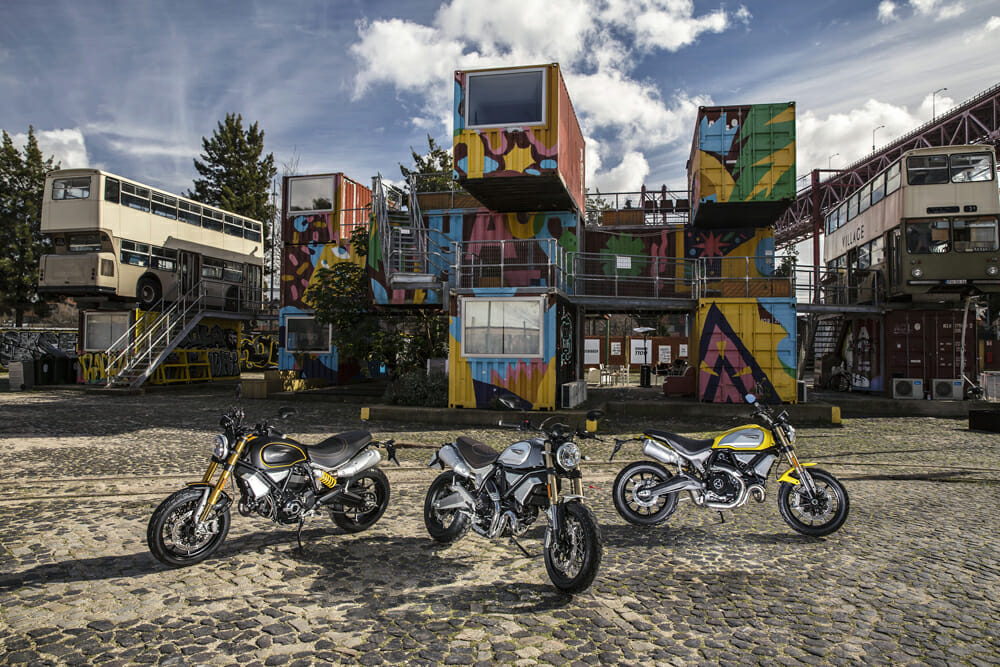 (L-R) The Scrambler 1100 Sport in Viper Black, the 1100 Special in Custom Grey, and the 1100 in ’62 Yellow.
(L-R) The Scrambler 1100 Sport in Viper Black, the 1100 Special in Custom Grey, and the 1100 in ’62 Yellow.
It’s been three years since Ducati first unveiled the Scrambler Icon, which has been a huge part of the standard-bike renaissance.
With its upright ergos and vintage-inspired styling, the Scrambler is made for customers who were less interested in increasing lap times, and more interested in the pure joy of being on two wheels.
The Scrambler has played a significant role in bringing back a genre of motorcycle that had been largely forgotten by most brands for the previous three decades. Call it a standard, call it a sit-up bike, call it a modern classic. No matter what label the Scrambler had, its aim is to bring motorcycling back to its simplest, purest form.
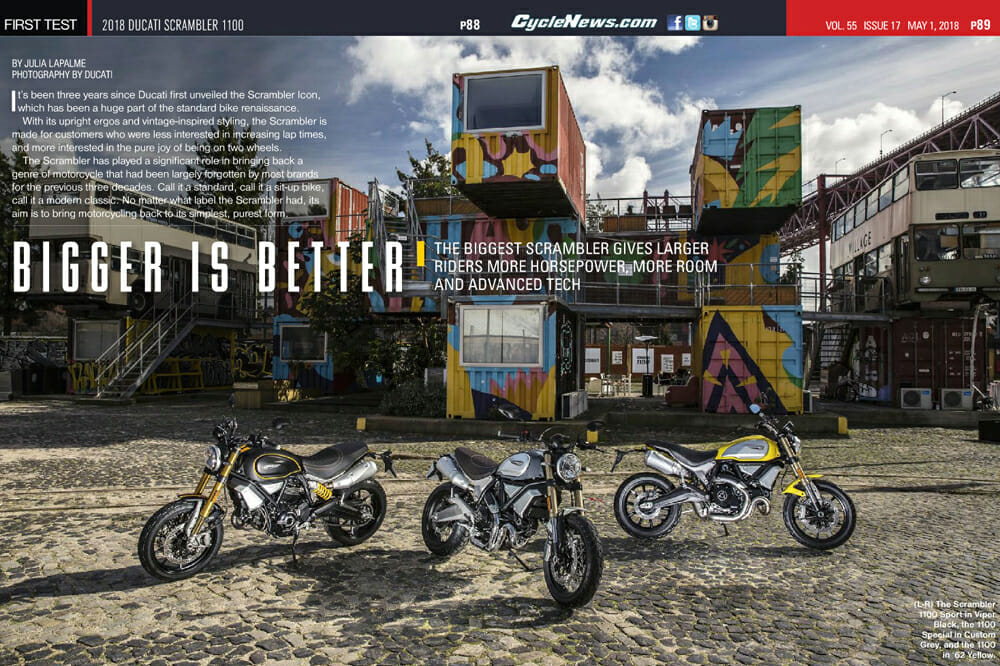
Click here to read this in the Cycle News Digital Edition Magazine.
By Julia LaPalme | Photography by Ducati
While the 800 and 400 models were well suited to the newer and shorter rider, they left taller and more experienced riders wanting more: more room for longer limbs and torsos, more power for heavier riders, higher speeds and longer freeway stints. Ducati’s answer? The Scrambler 1100.
The biggest addition to the Scrambler lineup combines all the charm and simple joys of a standard Scrambler, and enlarges the whole package by about 15 percent, with a newly designed chassis, longer swingarm, larger saddle and increased power. They even added new tech features to keep the advanced riders happy (and safe). So how does the new bike compare? We flew to Portugal to find out.
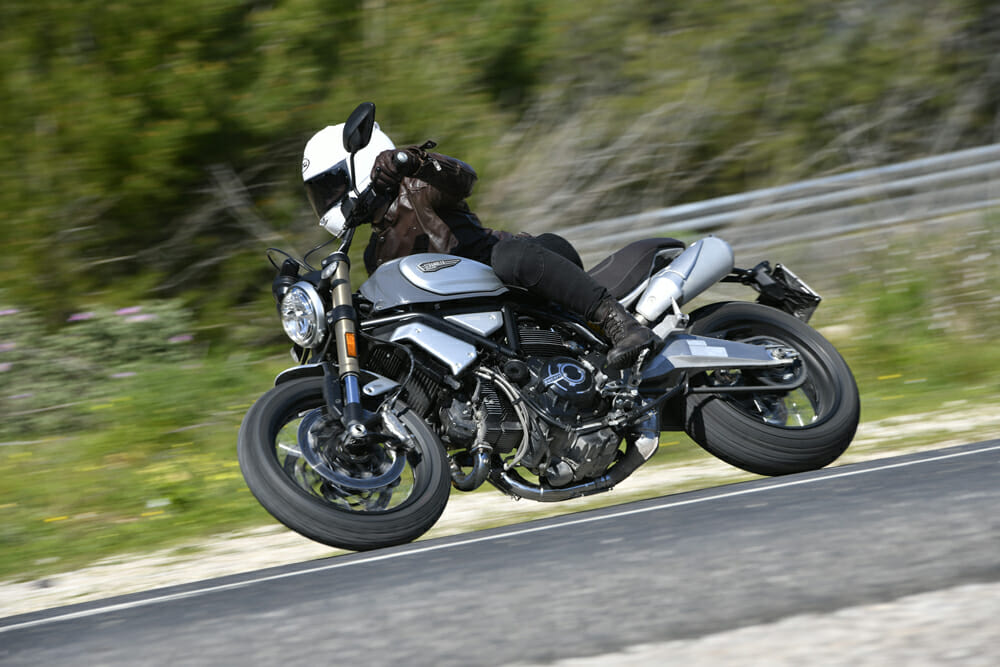 Turn-in is easy on the new Scrambler, and the suspension maintained composure in the corners.
Turn-in is easy on the new Scrambler, and the suspension maintained composure in the corners.
Portuguese Scrambling
At first glance, the Scrambler 1100 doesn’t look bigger, but throw a leg over the seat and reach for the handlebars, and the increased size is immediately apparent. Admittedly, this 5’5” test rider is better suited for the 800 or 400 models, but the 1100 is still a reasonable fit.
Everything about the ergos is obviously built for a larger rider. The seat feels taller, but it’s added height is exaggerated by the wider saddle. On the flip side, the newly designed chassis is narrower, making foot placement on the pegs more directly below the knees, instead of requiring a pigeon-toe position.
Since my height is more in my legs than my torso, the reach from the seat to the handlebars was noticeably longer, and the handlebars wider. On the Scrambler 1100 Special model we rode, the handlebars were lower than the standard 1100, so the riding position was a little more leaned forward than what we’ve come to expect from a Scrambler. Regardless, this slightly oversized ergo setup was easy to adapt to after half an hour in the saddle.
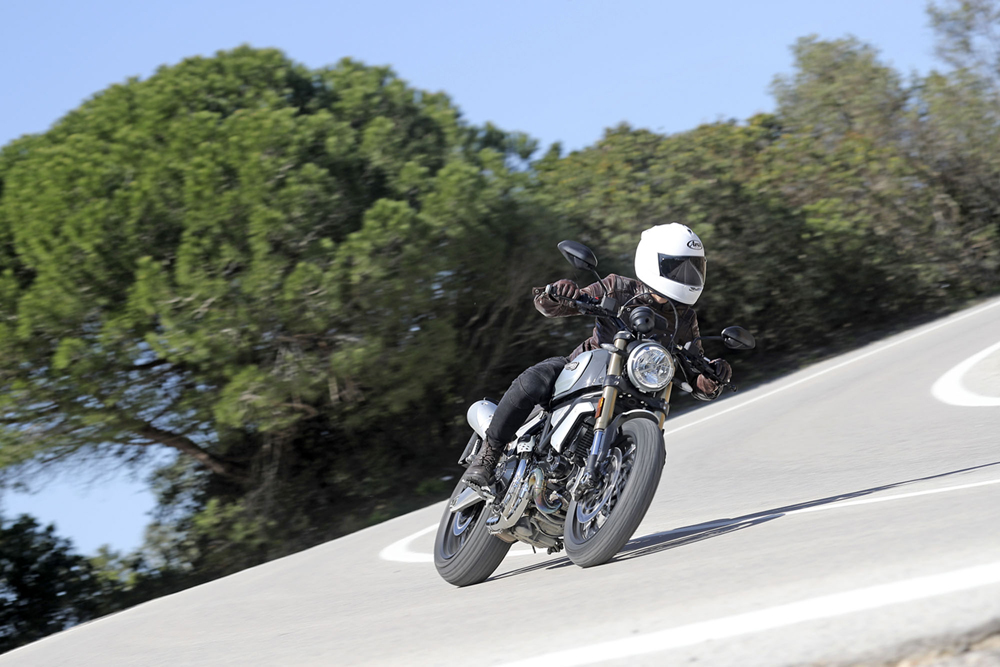 Increased legroom makes for a more comfortable, less cramped ride.
Increased legroom makes for a more comfortable, less cramped ride.
While the 1100 Scrambler’s powerplant is based on the Monster 1100 Evo, many adjustments were made for slimming the physical size of the engine, including reducing throttle bodies from two to one.
Twisting the throttle on this larger Scrambler revealed torque available earlier in the throttle play, and an overall smooth delivery of its claimed 86 horses, thanks to the new ride-by-wire.
It’s still an air-cooled V-twin that doesn’t jump and twitch if you merely breathe on the twist-grip, but it’s no slouch, either. Plus, it all depends on which ride mode you’re in that determines how responsive you want that throttle, and how much horsepower you really want to access.
Thumb through the menu options on the new LCD display, and you can go with one of the three default ride-mode settings for “Active,” “Journey” and “City,” which adjusts throttle response, horsepower and the Ducati Traction Control (DTC) system. As a bonus, each of these ride modes is fully customizable.
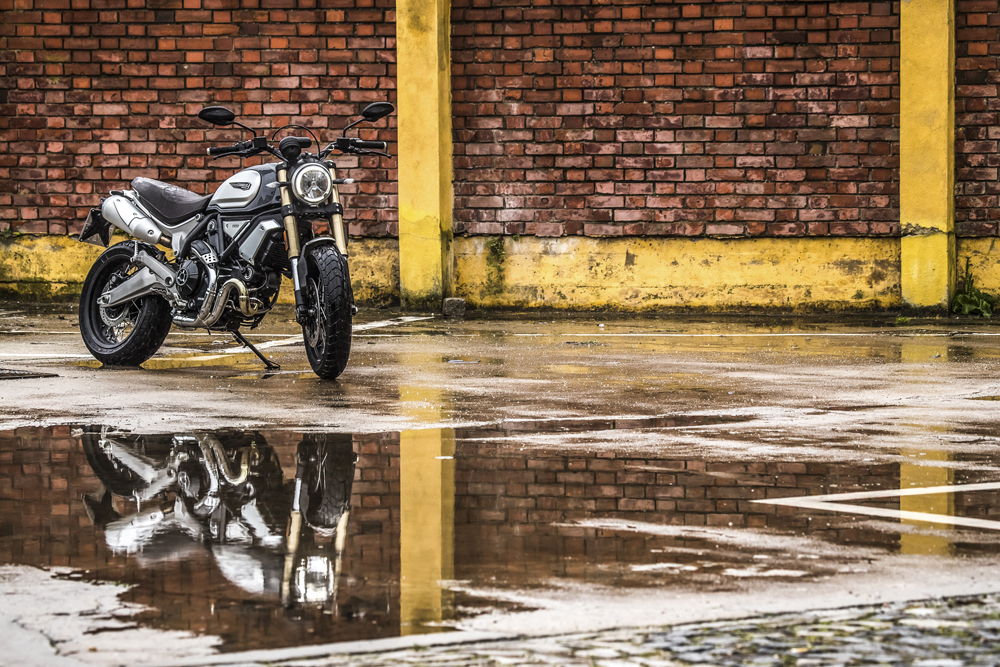 The Scrambler 1100 is bigger than its predecessors but doesn’t look bigger.
The Scrambler 1100 is bigger than its predecessors but doesn’t look bigger.
Since I spent most the day in Active mode, which is the most sensitive throttle response, full horsepower and level-two DTC, the 1100 was very responsive, but not jumpy. The larger engine’s increased horsepower over the 800 comes in especially handy for freeway riding. Torque kicks in early, making that power accessible when you really need it, especially when merging with traffic.
At cruising speeds, the 1100 took the miles and higher speeds in stride. I kept it in fourth gear on the freeway getting up to 75 mph, then remembered there are two more gears; shifting into sixth gear left the bike feeling like it was in overdrive. You’d be hard pressed to find a need for wide-open throttle on this big Scrambler.
Once we hit the back roads, the Marzocchi suspension revealed its full character as we carved through the twists and turns, helping the bike feel planted in the corners. Both front and rear suspension transferred a lot of the road’s surface, which was literally being uprooted by the trees flanking the road.
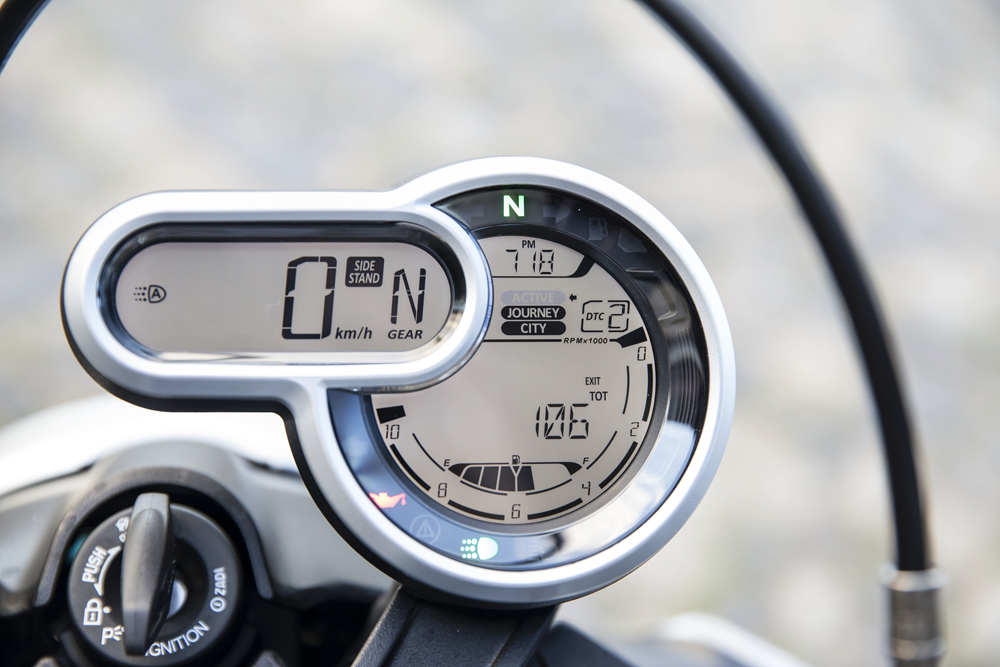 The new LCD display shows speed, odo, trip, ride mode and DTC selected.
The new LCD display shows speed, odo, trip, ride mode and DTC selected.
At mid-level settings the bike’s suspension was clearly prepped for a heavier rider, as I felt like the shock wasn’t compressing enough to absorb bumps in the road. After a quick roadside adjustment to shock preload and fork compression damping in between photo passes, the setup felt better suited to my 135 pounds.
Bumps and ruts didn’t upset the bike nearly as much, and the ride was much more comfortable. Upgrade to the Scrambler 1100 Sport, and you’ll get a full Ohlins setup, which offers even more refined suspension. Can’t wait to try that at some point.
Riding through the old-world European city of Lisbon posed plenty of stop-and-go opportunities during our test ride. Thankfully, the Brembo brakes felt strong, bringing the big bike to a stop with confidence, without any startling initial bite. Cornering ABS worked like a charm during a bit of traffic chaos when a car came to a sudden stop in front of me, amid our big group lane sharing.
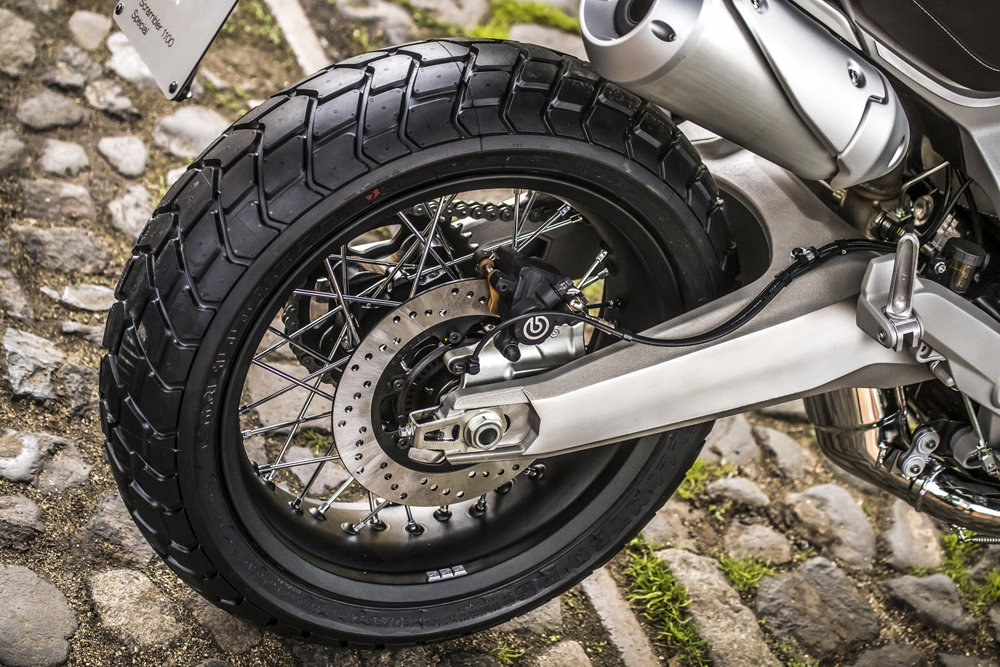 A longer swingarm is just one way that Ducati extended the new Scrambler’s size.
A longer swingarm is just one way that Ducati extended the new Scrambler’s size.
Later on, as we entered one of the multiple roundabouts, I was throttling out of the turn and felt the rear tire slip for a brief moment, then regain traction. That cornering DTC worked smoothly, without really calling attention to itself or upsetting the bike.
Despite the Scrambler 1100 being built for riders larger than myself, I quickly adapted to the taller seat and roomier rider triangle. The added power was an absolute delight, and I really appreciate the new tech features. I give the new Scrambler a big thumb’s up, especially if you liked the previous versions, but wanted something bigger.
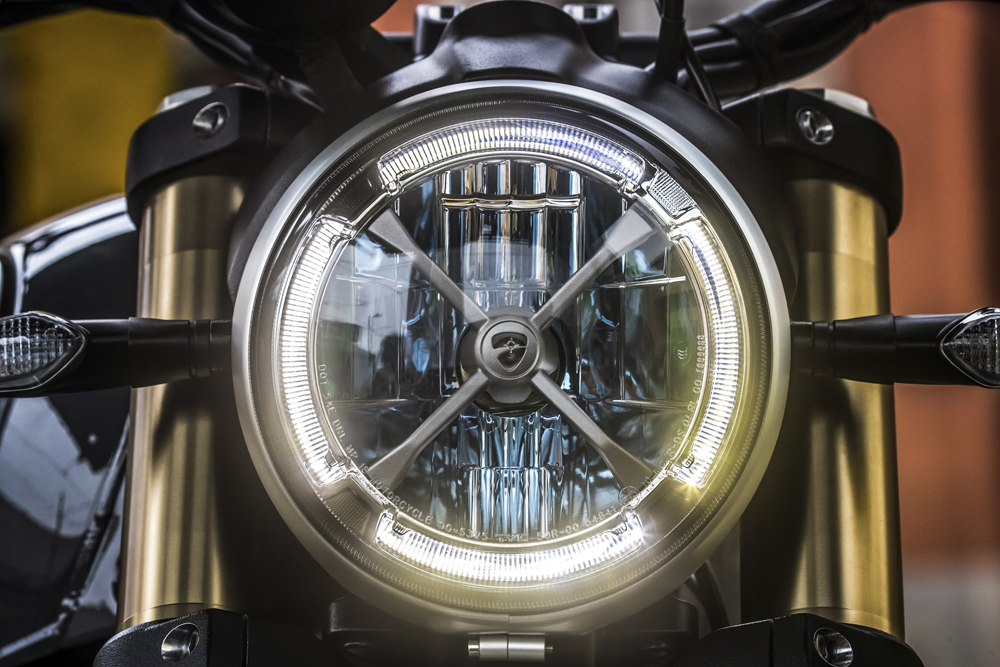 LED headlight features a similar cross design found elsewhere on the bike.
LED headlight features a similar cross design found elsewhere on the bike.
Scrambled Bones?
The new Scrambler 1100’s 1079cc V-twin, desmodromic powerhouse might share the same displacement as the Monster 1100 Evo, but according to Ducati, it has largely been redesigned.
“The only parts that are shared between the Monster 1100 Evo and the Scrambler 1100 are the pistons, rods, belts and Desmodromic system,” explains Claudio Fonti, vehicle project engineer. “All the other parts are completely new designs, or significantly updated for this specific application.”
Among other challenges, Fonti was faced with the task of updating the engine to meet Euro 4 regulations. One change that helped facilitate this was reducing valve overlap. “On the Monster it was 39 degrees, and now (on the Scrambler 1100), it’s only 16 degrees,” Fonti told us. This adjustment, in addition to newly featured ride-by-wire, is designed give smoother throttle response.
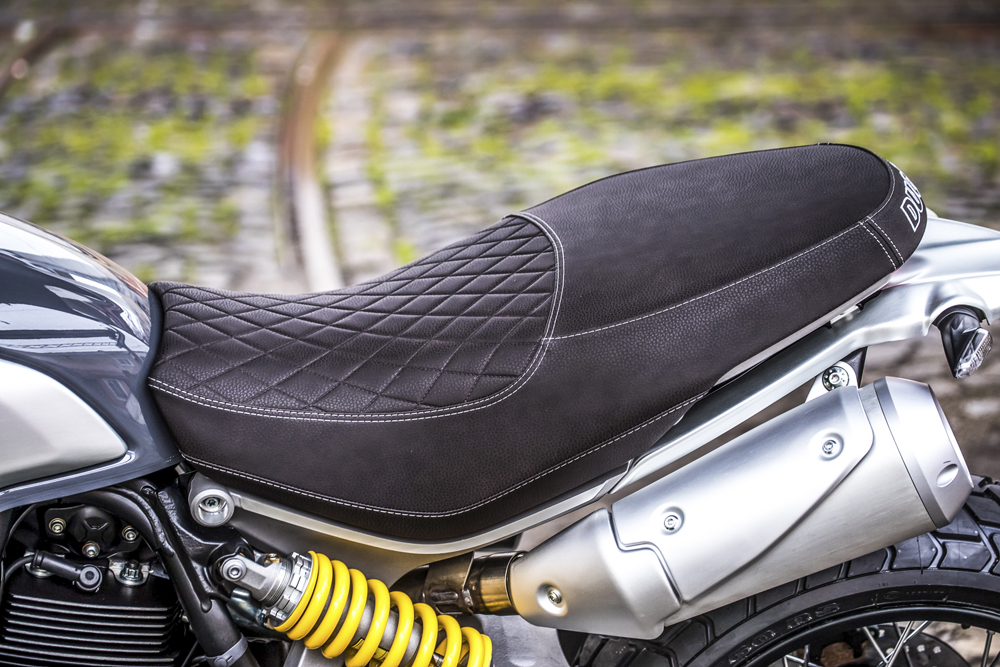 The bigger scrambler comes with a wider seat, meant to accommodate the larger rider.
The bigger scrambler comes with a wider seat, meant to accommodate the larger rider.
Fonti worked in concert with Scrambler designer Jeremy Faraud to slim down the engine to accommodate a narrower chassis, which in turn makes the Scrambler’s increased height more manageable. “Now we have a single throttle body at 55mm diameter,” Fonti said. “This helps because we had the opportunity to install the throttle body inside the airbox and (keep) the bike compact.” Faraud, who was tasked with designing the new Scrambler noted, “The biggest challenge was designing a larger Scrambler, while keeping the proportions correct, so it didn’t look out of place.” The narrower chassis was part of that goal, and is offset by the longer swingarm, which increases the 1100’s footprint.
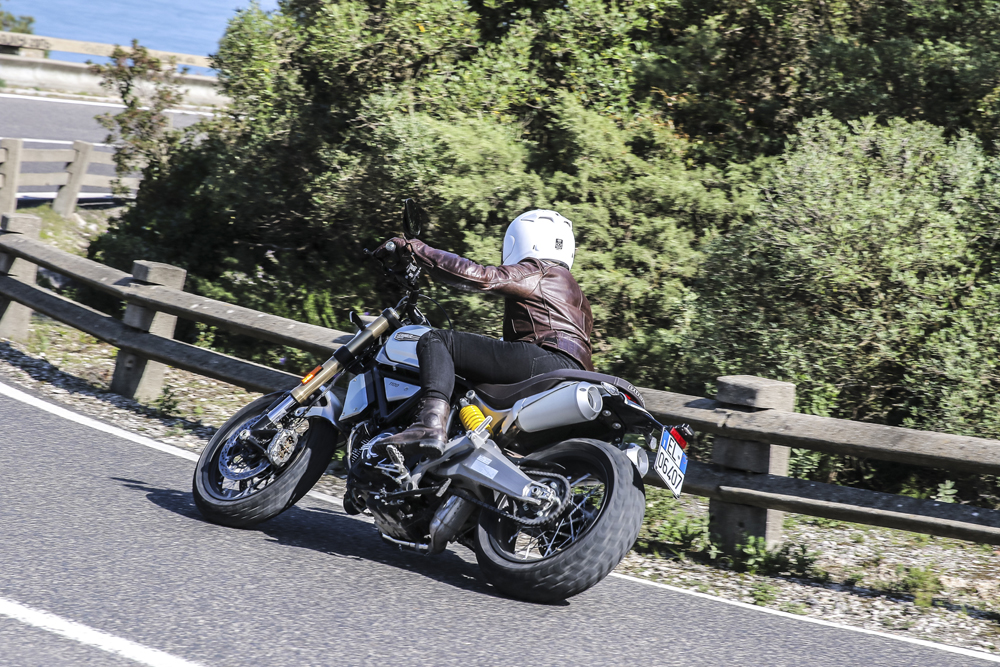 Symmetrical high pipes create a nice tail section and deliver a symphony of L-twin growls.
Symmetrical high pipes create a nice tail section and deliver a symphony of L-twin growls.
In the cockpit, a new LCD gauge displays menus accessing technology entirely new to the Scrambler lineup, specifically the ride modes, Cornering ABS and DTC. As mentioned earlier, the Scrambler 1100 is equipped with three ride modes: Active, Journey and City. In their default settings, Active is the equivalent to other ride modes labeled Sport, offering the most immediate throttle response, full horsepower, and minimal DTC (set to level two). Journey is the equivalent of Standard, which is set to less immediate throttle response, while maintaining full horsepower, and DTC set to level three. City is similar to what is usually referred to as Rain mode, with a much slower throttle response, engine output dialed back to 75 horsepower, and DTC set to level four, the maximum setting. The great thing about these ride modes is each one can be customized, adjusting how much horsepower, throttle sensitivity and DTC you want for each preset. There are four levels of DTC, plus the option to turn it off entirely, which will make the more experienced riders happy.
The 1100 is the first Scrambler to feature Cornering ABS, utilizing Bosch’s Inertial Measurement Unit (IMU). ABS has already become increasingly common in new motorcycles, a safety feature mandatory in Europe for all new bikes above 125cc. But cornering ABS is still an advanced feature generally reserved for the higher-end models, so it’s nice to see it used here in the Scrambler 1100. An added bonus, which uses the IMU, is self-canceling turn signals; another new feature for the Scrambler lineup.
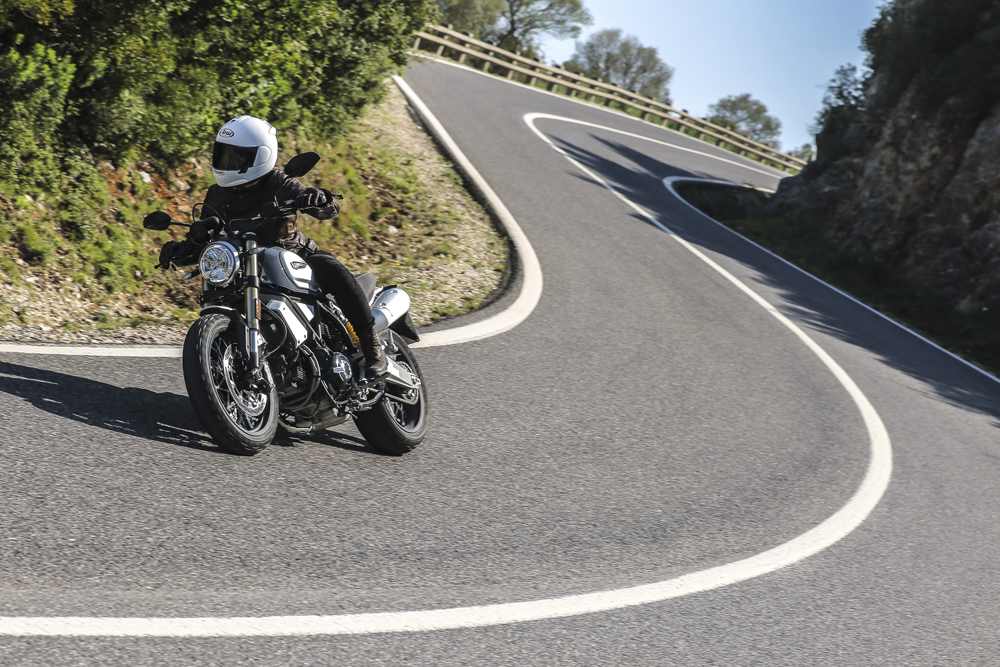 The Pirelli MT 60s allowed for plenty of lean angle, though they claim 60/40 city/back roads.
The Pirelli MT 60s allowed for plenty of lean angle, though they claim 60/40 city/back roads.
The Scrambler 1100 comes in four different colorways: the standard is available in ’62 Yellow and Shining Black, for $12,995; the 1100 Special is available in Custom Grey, and is offered at $14,295; and the 1100 Sport, available in Viper Black, is priced at $14,995. Bikes should hit dealer showroom floors on Star Wars Day (May the 4th). CN
Accessories for you, good sir?
Ducati has always touted the Scrambler as its most easily accessorized bike; a huge part of the ethos of the entire Scrambler movement is customization. To that point, a slough of new accessories were added to Scrambler’s already robust catalog, including Termignoni Racing Silencers ($1499), a Magnetic Tank Bag ($289), a brown, diamond quilted Premium Seat ($350), and black, diamond quilted Special Seat ($319) and Manifold Kit ($999). A handful of aluminum accessories add an extra bit of flare, including Tank Panels ($299), a Spoke Rim Set ($1599), and Front and Rear Mudguards ($499).
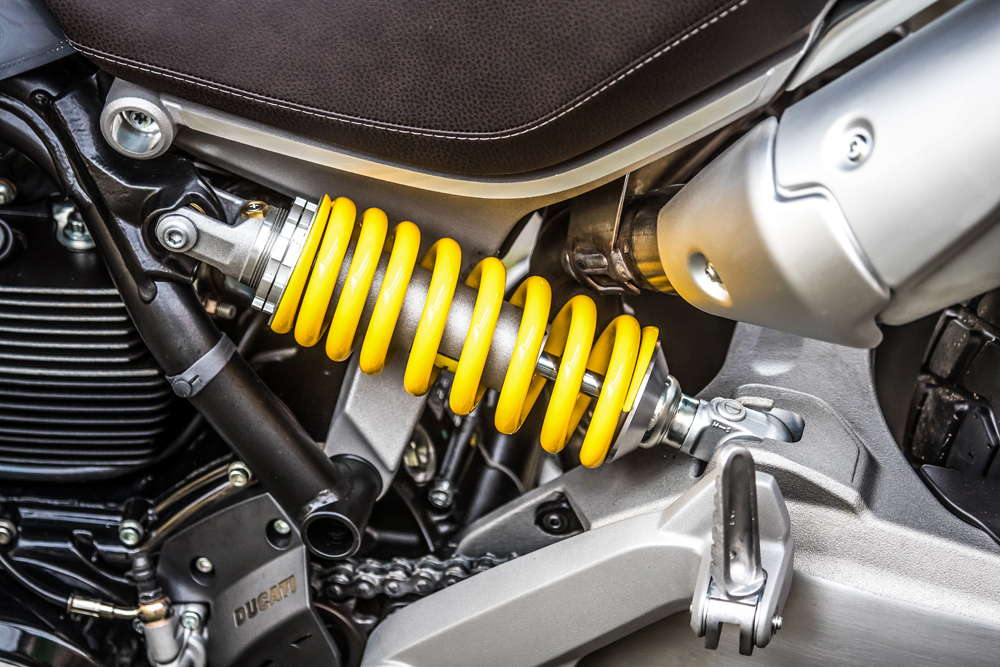 The Marzocchi suspension is fully adjustable both front and rear.
The Marzocchi suspension is fully adjustable both front and rear.
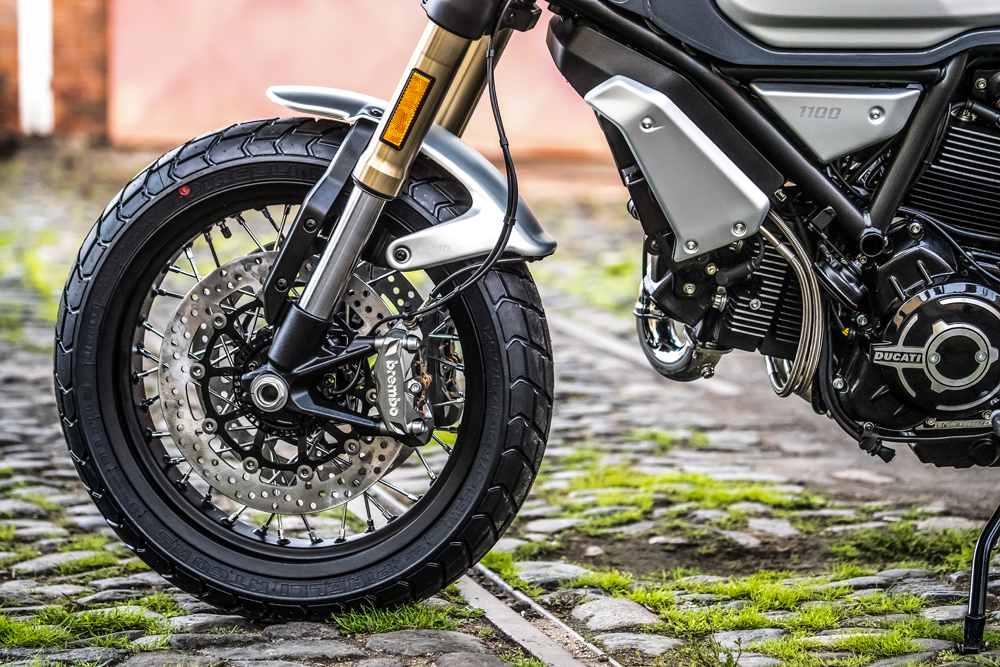 Cornering ABS on the 1100 is new for the Scrambler lineup.
Cornering ABS on the 1100 is new for the Scrambler lineup.
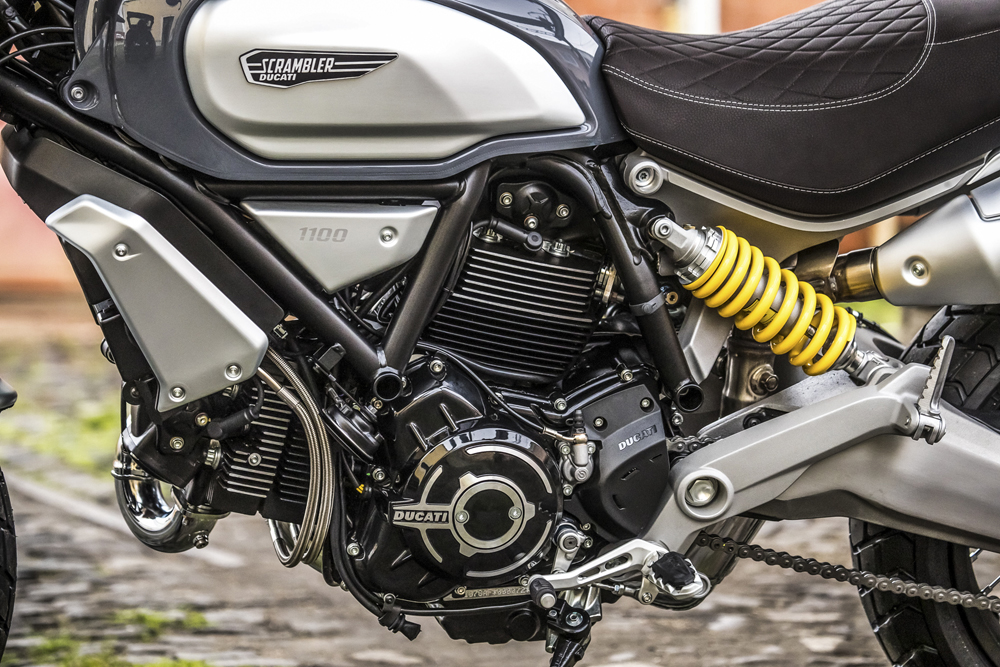 The Scrambler 1100’s 1079cc engine was completely re-designed to make it fit into the brand new narrower chassis.
The Scrambler 1100’s 1079cc engine was completely re-designed to make it fit into the brand new narrower chassis.
The icing on the accessory cake is a special line of Rizoma parts released especially for the Scrambler 1100. These bits of bling include a billet aluminum headlight trim ($200), front brake and clutch-fluid reservoir covers ($85 each), billet-aluminum tank cap ($220) and footpegs (price unlisted). Because who doesn’t want to farkle their Italian bike with more… um, Italia?
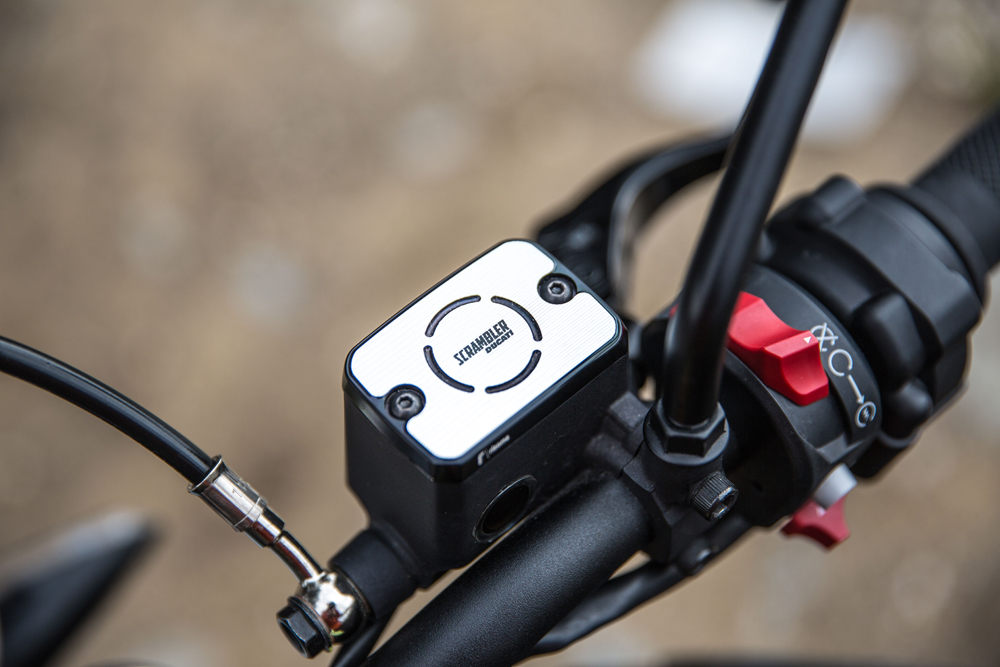 One of the new pieces in the Scrambler 1100 Rizoma accessories lineup is this clutch-fluid reservoir cover.
One of the new pieces in the Scrambler 1100 Rizoma accessories lineup is this clutch-fluid reservoir cover.
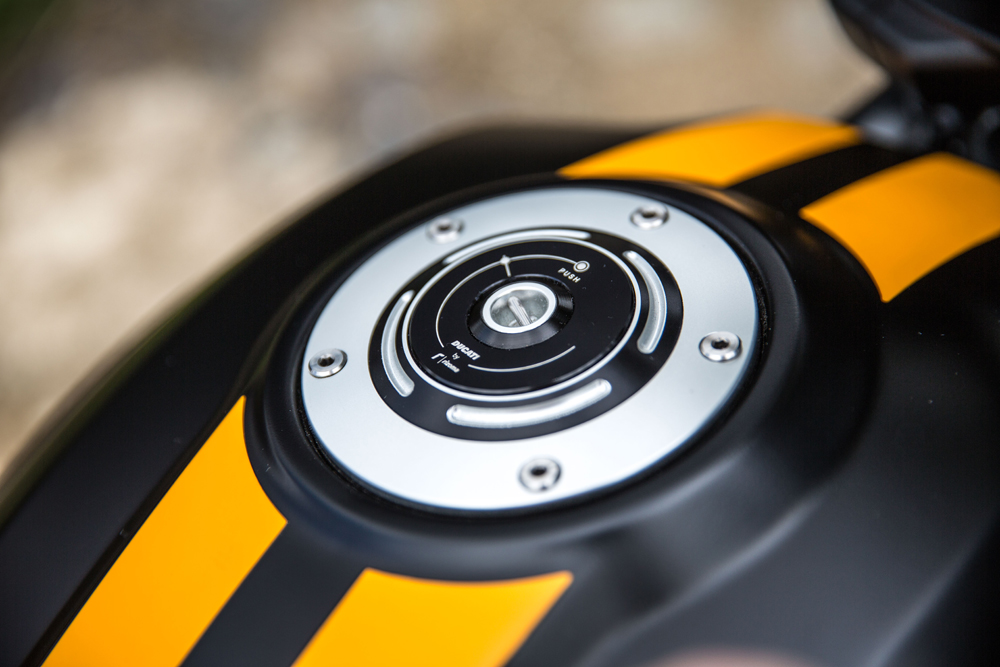 The Rizoma gas cap for the Scrambler 1100 adds extra bling.
The Rizoma gas cap for the Scrambler 1100 adds extra bling.
Scrambler history in a nutshell
Ducati’s first Scrambler rolled off the assembly line in 1962, aimed squarely at the American market, and was received with great enthusiasm. With a 250cc single-cylinder engine, the new off-road-capable bike was sold as a “four-in-one,” meant to serve as a street bike, road racer, enduro and flat tracker. It’s easy to see where the modern day Scramblers get their inspiration. In 1964, a five-speed version was released, and then later a 350 came out in 1968.
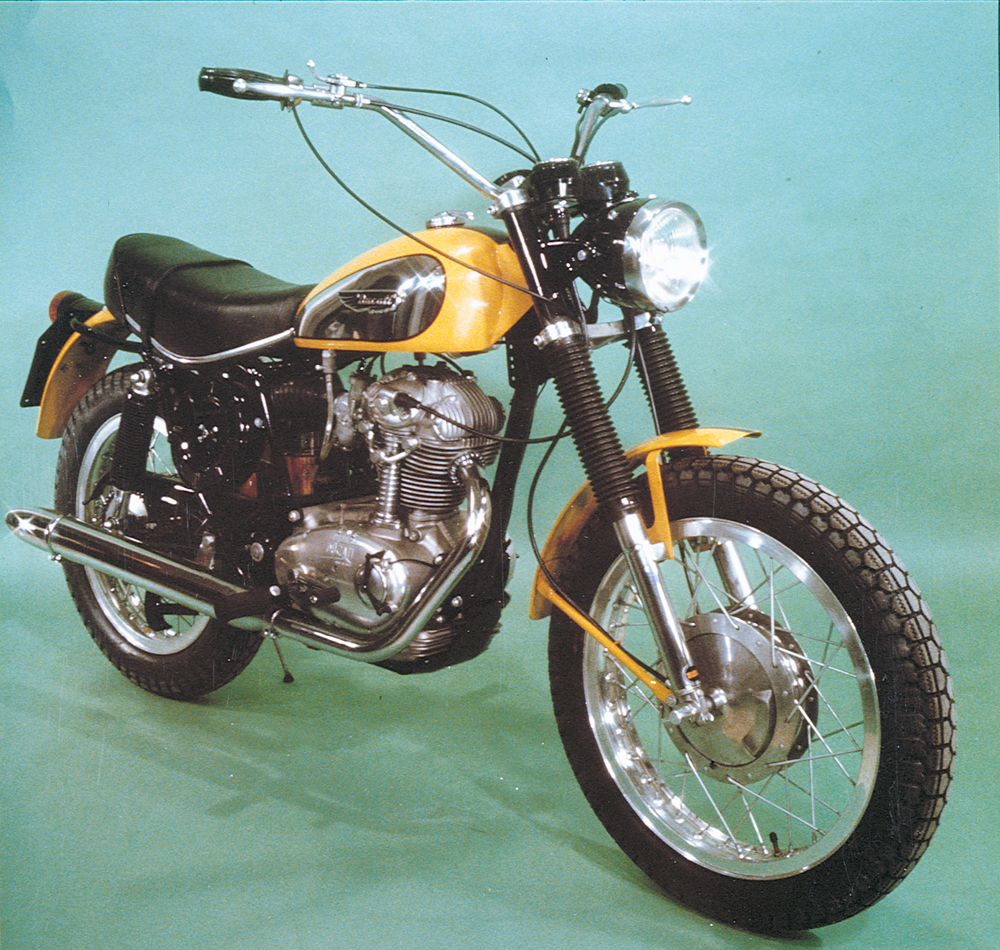 The OG Ducati Scrambler 450 in all its glory.
The OG Ducati Scrambler 450 in all its glory.
In 1969, the 450 Scrambler “Jupiter” was being made here in the states, but was much more road-oriented. The largest of the first generation of Scramblers, this model was built until 1976, after which Scrambler production was halted. Ducati went on to focus more heavily on road and racing models through the ’70s, ’80s and ’90s, mostly with full fairings and increasing horsepower. It would be four decades before we would see the moniker return, with the new generation of Scramblers as we know them today.

| SPECIFICATIONS |
2018 Ducati Scrambler 1100 ($12,995) |
| Engine: |
L-Twin, Desmodromic valve distribution, four-valve, air-cooled |
| Displacement: |
1079cc |
| Bore x stroke: |
98 x 71mm |
| Compression ratio: |
11:1 |
| Power: |
86 hp @ 7500 rpm |
| Torque: |
65 lb-ft @ 4750 rpm |
| Clutch: |
Wet multi-plate |
| Transmission: |
6-speed |
| Chassis: |
Tubular steel trellis frame |
| Front suspension: |
45mm Marzocchi inverted fork, fully adjustable |
| Rear suspension: |
Kayaba monoshock, preload, rebound adjustable |
| Front wheel travel: |
5.9 in. |
| Rear wheel travel: |
5.9 in. |
| Front brake: |
Dual 320mm semi-floating discs, radially mounted Brembo monobloc M4.32 four-piston calipers; Bosch cornering ABS as standard |
| Rear brake: |
245mm disc, single-piston floating caliper with Bosch cornering ABS as standard |
| Front tire: |
Pirelli MT 60 RS 120/80 ZR18 |
| Rear tire: |
Pirelli MT 60 RS 180/55 ZR17 |
| Rake: |
24.5° |
| Wheelbase: |
59.6 in. |
| Seat height: |
31.9 in. |
| Fuel capacity: |
3.96 gal. |
| Weight (wet, claimed): |
454 lbs. |